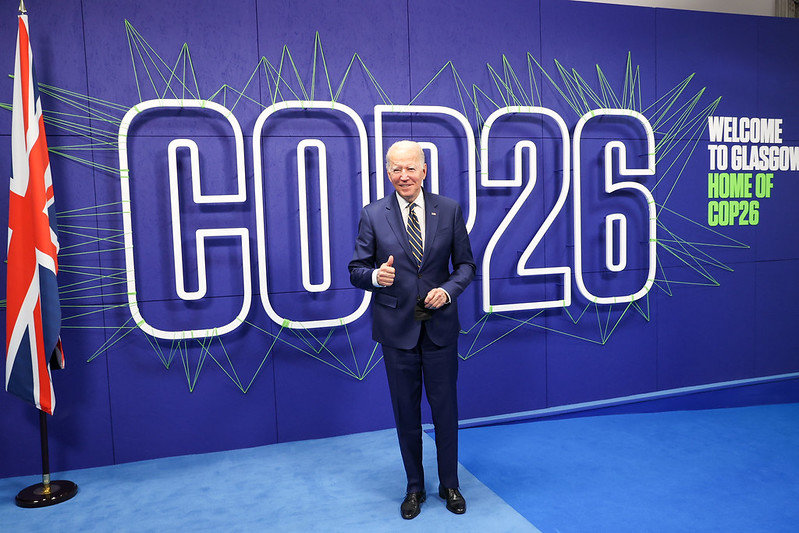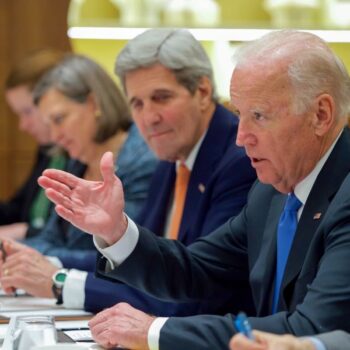Data trends: 🟢 COP26 Progress: 🟠 2022 Momentum: 🟠
COP26 was a significant moment for US diplomacy, as the country re-entered UNFCCC negotiations as a potentially progressive force for the first time in four years. The COP Presidency’s explicit focus on ‘consigning coal to history’ presented an opportunity for the Biden administration to demonstrate domestic progress that would support claims to US international leadership. Unfortunately, the difficulties of domestic politics interfered, leaving the US underpowered internationally.
US coal phase-out must accelerate to align with Paris commitments

The US operating coal fleet stood at 233GW in mid-2021 – 11% of the global total. This has fallen rapidly over the past decade, driven by the declining economic viability of coal, an increasing dependency on natural gas, and requirements for pollution controls leaving ageing plants not compliant. Meanwhile, no new coal power plants have been constructed since 2013.
E3G analysis finds that the US has seen 34% of coal capacity close since 2010, with an additional 57% set to retire by 2030. This is significant progress but leaves 152GW that could still be online in the 2030s, incompatible with below-1.5°C pathways. Business-as-usual scenarios show coal generation slowly declining, but recent analyses find that US coal retirements need to increase by over 60% to stay in line with the Paris Agreement. Further domestic policy action will be essential to accelerating this process.
Warm words offset lack of formal commitment to a Paris-aligned exit for coal at COP26
The US did not sign the high-profile Global Coal-to-Clean Power Statement at COP26, where 46 countries committed to exit coal in the 2030s or 2040s and ‘no new coal’. The US was, however, willing to sign the commitment to end international public financing for unabated fossil fuels. A mid-COP surprise was the US-China Joint Declaration on Enhancing Climate Action. While this failed to mention US action on domestic coal, it flagged the need to accelerate the low carbon transition and emissions reductions through enhanced cooperation. Finally, the US agreed to the final Glasgow Climate Pact, which referred to the ‘phase-down’ of unabated coal and ending inefficient fossil fuel subsidies.
The US’ failure to formally align with other OECD countries was partially offset by Biden’s Climate Envoy John Kerry stating that “by 2030…the United States…won’t have coal”. This sent a tacit signal that US international leadership increasingly recognizes the reality that a 2030 coal exit is desirable and inevitable, despite the need to manage difficult domestic politics.
Domestic politics block international US commitments
Domestic political shenanigans appear to have been the biggest barrier to the US making a formal commitment to a 2030 coal exit. President Biden’s proposed Build Back Better bill, was held up by West Virginia Senator Joe Manchin’s refusal to support the legislation. The coal miners’ union in West Virginia has urged Manchin to reconsider, as it contains funding that would aid workers as the industry wanes. Likely prompted by this pressure, Manchin mentioned that he was open to agreeing on the climate provisions of the bill.
Practical federal policy action can accelerate the transition away from coal. A recent Environmental Protection Agency rule to reduce wastewater pollution will likely lead to 21 additional coal plants closing before 2030. The 2021 announcement that the US is aiming for a “carbon pollution-free power sector by 2035” and a national commitment to cut emissions by at least 50 percent by 2030 send clear signals. These objectives require a Just Transition for coal-dependent states, something the Administration has recognized by forming an inter-agency working group and engaging with States and stakeholders.
Resolving domestic action could set the US international leadership in coal phase-out
President Biden asked at COP26, “Will we do what is necessary? Will we seize the enormous opportunity?”. The challenge is that keeping 1.5°C alive depends on OECD countries like the US rapidly phasing out coal this decade. A coal exit by 2030, a scale up of renewables and a just transition for coal communities would give the US credibility and expertise for green international leadership.
Working with the EU and international financial institutions, the US can help deliver the South Africa Just Energy Transition and use this as a blueprint for others. The Build Back Better World (B3W) and Net Zero World initiatives allow the US to leverage additional finance for the coal to clean transition, delivered through country partnerships like India and Indonesia. The US can also help build political momentum around the global energy transition from within the G7 and G20. These must be priorities for 2022, facilitated by the reputational boost of a US showing it is on track to deliver a coal exit by 2030.


